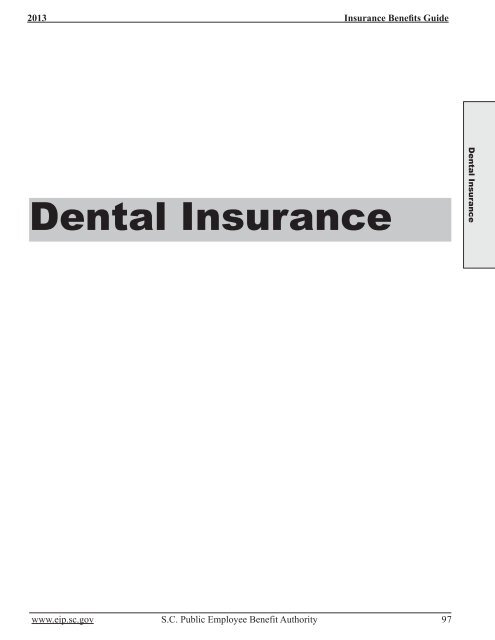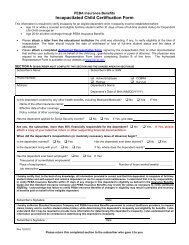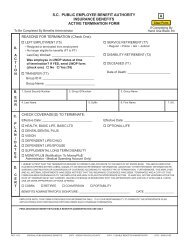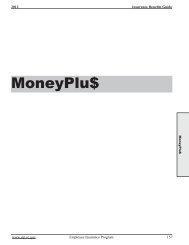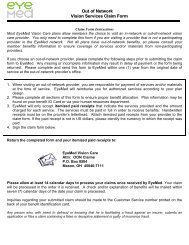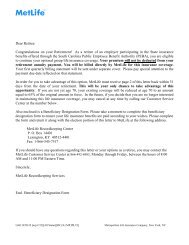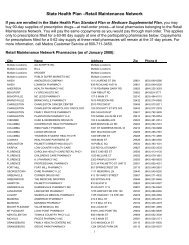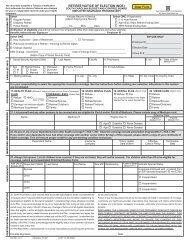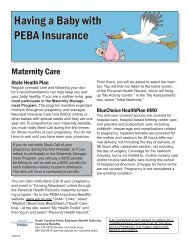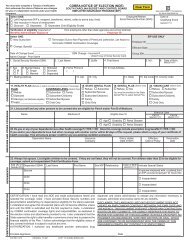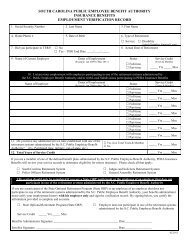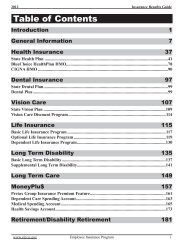Dental Insurance - South Carolina Public Employee Benefit Authority
Dental Insurance - South Carolina Public Employee Benefit Authority
Dental Insurance - South Carolina Public Employee Benefit Authority
You also want an ePaper? Increase the reach of your titles
YUMPU automatically turns print PDFs into web optimized ePapers that Google loves.
2013 <strong>Insurance</strong> <strong>Benefit</strong>s Guide<br />
<strong>Dental</strong> <strong>Insurance</strong><br />
<strong>Dental</strong> <strong>Insurance</strong><br />
www.eip.sc.gov S.C. <strong>Public</strong> <strong>Employee</strong> <strong>Benefit</strong> <strong>Authority</strong> 97
<strong>Insurance</strong> <strong>Benefit</strong>s Guide 2013<br />
<strong>Dental</strong> <strong>Insurance</strong><br />
<strong>Dental</strong> <strong>Insurance</strong><br />
Table of Contents<br />
Introduction.......................................................................................................................... 99<br />
State <strong>Dental</strong> Plan....................................................................................................................................... 99<br />
<strong>Dental</strong> Plus................................................................................................................................................. 99<br />
<strong>Dental</strong> <strong>Benefit</strong>s at a Glance................................................................................................ 100<br />
Claim Example (using Class III procedure)......................................................................................... 101<br />
State <strong>Dental</strong> Plan Only......................................................................................................................... 101<br />
State <strong>Dental</strong> Plan with <strong>Dental</strong> Plus...................................................................................................... 101<br />
How to File a <strong>Dental</strong> Claim.................................................................................................................... 101<br />
Special Provisions of the State <strong>Dental</strong> Plan.......................................................................................... 102<br />
Alternate Forms of Treatment.............................................................................................................. 102<br />
Pretreatment Estimates......................................................................................................................... 102<br />
Exclusions: <strong>Dental</strong> <strong>Benefit</strong>s not Offered .............................................................................................. 102<br />
General <strong>Benefit</strong>s not Offered............................................................................................................... 103<br />
<strong>Benefit</strong>s Covered by Another Plan....................................................................................................... 103<br />
Specific Procedures not Covered......................................................................................................... 103<br />
Limited <strong>Benefit</strong>s................................................................................................................................... 104<br />
Coordination of <strong>Benefit</strong>s......................................................................................................................... 105<br />
How Coordination of <strong>Benefit</strong>s Works with <strong>Dental</strong> Coverage.............................................................. 105<br />
Appeals..................................................................................................................................................... 106<br />
98 S.C. <strong>Public</strong> <strong>Employee</strong> <strong>Benefit</strong> <strong>Authority</strong> www.eip.sc.gov
2013 <strong>Insurance</strong> <strong>Benefit</strong>s Guide<br />
Introduction<br />
Your teeth are important to your health. That is why PEBA offers the State <strong>Dental</strong> Plan, which helps offset<br />
your dental expenses, and <strong>Dental</strong> Plus, a supplement to the State <strong>Dental</strong> Plan. To participate in <strong>Dental</strong> Plus,<br />
you must enroll in the State <strong>Dental</strong> Plan and cover the same family members under both plans.<br />
State <strong>Dental</strong> Plan<br />
The State <strong>Dental</strong> Plan offers these levels of treatment: diagnostic and<br />
preventive; basic; prosthodontics; and orthodontics. They are described<br />
on the next page. The lifetime orthodontics payment is $1,000 for each<br />
covered child age 18 and younger. State <strong>Dental</strong> Plan benefits are paid<br />
based on the allowed amounts for each dental procedure listed in the<br />
plan’s Schedule of <strong>Dental</strong> Procedures and Allowed Amounts. Be aware<br />
that your dentist’s charge may be greater than the allowed amount.<br />
The maximum yearly benefit for the State <strong>Dental</strong> Plan alone is $1,000<br />
for each subscriber or covered person. The State <strong>Dental</strong> Plan deductible<br />
is $25 annually for each covered person who has dental services under<br />
Class II or Class III. The deductible for family coverage is limited to<br />
three per family per year, $75.<br />
If you enroll in the State <strong>Dental</strong><br />
Plan or <strong>Dental</strong> Plus, you<br />
may not drop that coverage<br />
until the next open enrollment,<br />
which will be in October<br />
2013, or until you become<br />
eligible to change coverage<br />
due to a special eligibility<br />
situation. Special eligibility<br />
situations are explained on<br />
pages 23-29.<br />
<strong>Dental</strong> <strong>Insurance</strong><br />
<strong>Dental</strong> Plus<br />
<strong>Dental</strong> Plus covers the first three levels of treatment at the same percentage as the State <strong>Dental</strong> Plan. However,<br />
the allowed amount is higher. <strong>Dental</strong> Plus does not cover orthodontics.<br />
Under <strong>Dental</strong> Plus, payment for a covered service is based on the lesser<br />
Premiums for employees<br />
of the dentist’s charge or the <strong>Dental</strong> Plus allowed amount. This means<br />
are on the next page. Premiums<br />
for all subscribers are<br />
you may only be responsible for any deductibles and coinsurance that<br />
apply. If your dentist charges more for covered services than the <strong>Dental</strong><br />
Plus allowed amount, you will be responsible for paying the difference on pages 225-228.<br />
(plus deductibles and coinsurance), unless your dentist has agreed to<br />
accept the <strong>Dental</strong> Plus allowed amount as part of participation in the <strong>Dental</strong> Plus provider network.<br />
PEBA <strong>Insurance</strong> <strong>Benefit</strong>s offered agreements to all <strong>South</strong> <strong>Carolina</strong> dentists to accept the lesser of their usual<br />
charge or the <strong>Dental</strong> Plus allowed amount. For a list of dentists who have accepted the agreement, go to the<br />
PEBA <strong>Insurance</strong> <strong>Benefit</strong>s website, www.eip.sc.gov. Select “Links” then under “State <strong>Dental</strong> Plan/<strong>Dental</strong><br />
Plus,” select “BlueCross BlueShield of SC.” At the BlueCross BlueShield of <strong>South</strong> <strong>Carolina</strong> (BCBSSC) website,<br />
select “Member” and then “Find a Provider.” Under “Doctor & Hospital Finder,” select “<strong>Dental</strong> Care.”<br />
Now select “General <strong>Dental</strong> Practitioners.” Under “Specialty Category” select “State <strong>Dental</strong> Plus.”<br />
If your dentist has not accepted PEBA <strong>Insurance</strong> <strong>Benefit</strong>’s agreement, your benefits under <strong>Dental</strong> Plus will<br />
not be reduced. However, you will be responsible for the difference between your dentist’s charge and the<br />
<strong>Dental</strong> Plus allowed amount plus deductibles and coinsurance.<br />
The maximum yearly benefit for a person covered by both the State <strong>Dental</strong> Plan and <strong>Dental</strong> Plus is $2,000.<br />
There are no additional deductibles under <strong>Dental</strong> Plus.<br />
BCBSSC is the third-party claims processor for the State <strong>Dental</strong> Plan and <strong>Dental</strong> Plus. Its address is P.O.<br />
Box 100300, Columbia, SC 29202-3300. Its Customer Service number is 888-214-6230 or 803-264-7323<br />
(Greater Columbia area). The fax number is 803-264-7739.<br />
www.eip.sc.gov S.C. <strong>Public</strong> <strong>Employee</strong> <strong>Benefit</strong> <strong>Authority</strong> 99
<strong>Insurance</strong> <strong>Benefit</strong>s Guide 2013<br />
<strong>Dental</strong> <strong>Benefit</strong>s at a Glance<br />
Not all dental procedures are covered. Reimbursement is based on the lesser of the dentist’s actual<br />
charge or the plan’s allowed amount. Please see page 101 for more information.<br />
Class<br />
Covered<br />
<strong>Benefit</strong>s<br />
Plan<br />
Yearly<br />
Deductible<br />
Percent<br />
Covered<br />
Maximum<br />
Payment<br />
<strong>Dental</strong> <strong>Insurance</strong><br />
I<br />
Diagnostic and<br />
Preventive<br />
|<br />
II<br />
Basic<br />
<strong>Benefit</strong>s<br />
III<br />
Prosthodontics<br />
IV<br />
Orthodontics 1<br />
Exams<br />
Cleaning and scaling<br />
of teeth<br />
Fluoride treatment<br />
Space maintainers<br />
(child)<br />
Emergency pain relief<br />
X-rays<br />
Fillings<br />
Extractions<br />
Oral surgery<br />
Endodontics (root<br />
canals)<br />
Periodontal<br />
procedures<br />
Onlays<br />
Crowns<br />
Bridges<br />
Dentures<br />
Implants<br />
Repair of prosthodontic<br />
appliances<br />
Limited to covered<br />
children age 18<br />
and younger.<br />
Correction of<br />
malocclusion<br />
Consisting of:<br />
diagnostic services<br />
(including models and<br />
X-rays)<br />
Active treatment<br />
(including necessary<br />
appliances)<br />
State <strong>Dental</strong><br />
Plan alone<br />
with<br />
<strong>Dental</strong> Plus<br />
State <strong>Dental</strong><br />
Plan alone<br />
with<br />
<strong>Dental</strong> Plus<br />
State <strong>Dental</strong><br />
Plan alone<br />
with<br />
<strong>Dental</strong> Plus<br />
State <strong>Dental</strong><br />
Plan alone<br />
<strong>Dental</strong> Plus<br />
None<br />
None<br />
$25 per person. If<br />
you have services in<br />
Classes II and III, you<br />
pay only one deductible.<br />
Limited to three<br />
per family per year.<br />
No additional<br />
deductible<br />
$25 per person. If<br />
you have services in<br />
Classes II and III, you<br />
pay only one deductible.<br />
Limited to three<br />
per family per year.<br />
No additional<br />
deductible<br />
None<br />
<strong>Dental</strong> Plus does<br />
not cover<br />
orthodontic<br />
benefits<br />
100% of<br />
allowed amount<br />
100% of<br />
allowed amount<br />
80% of<br />
allowed amount<br />
80% of<br />
allowed amount<br />
50% of<br />
allowed amount<br />
50% of<br />
allowed amount<br />
50% of<br />
allowed amount<br />
<strong>Dental</strong> Plus does<br />
not cover<br />
orthodontic<br />
benefits<br />
$1,000 per person<br />
each year, combined<br />
for Classes I,<br />
II and III<br />
$2,000 2 per person<br />
each year, combined<br />
for Classes I,<br />
II and III.<br />
$1,000 per person<br />
each year, combined<br />
for Classes I,<br />
II and III<br />
$2,000 2 per person<br />
each year, combined<br />
for Classes I,<br />
II and III<br />
$1,000 per person<br />
each year, combined<br />
for Classes I,<br />
II and III<br />
$2,000 2 per person<br />
each year, combined<br />
for Classes I,<br />
II and III<br />
$1,000 lifetime<br />
benefit for each<br />
covered child<br />
<strong>Dental</strong> Plus does<br />
not cover<br />
orthodontic<br />
benefits<br />
1<br />
A subscriber must submit a letter from his provider for a covered child, age 18 and younger, stating that the child’s orthodontic<br />
treatment is not for cosmetic purposes for it to be covered by the State <strong>Dental</strong> Plan.<br />
2<br />
$2,000 is the maximum yearly payment for benefits when a member is enrolled in both the State <strong>Dental</strong> Plan and <strong>Dental</strong> Plus.<br />
Active <strong>Employee</strong><br />
Monthly Premiums<br />
(Rates for local subdivisions<br />
may vary. To check these<br />
rates, employees should<br />
contact their benefits office.)<br />
<strong>Dental</strong> <strong>Dental</strong> Plus Combined <strong>Dental</strong>/<strong>Dental</strong> Plus<br />
<strong>Employee</strong> $ 0.00 $22.60 $22.60<br />
<strong>Employee</strong>/spouse $ 7.64 $45.66 $53.30<br />
<strong>Employee</strong>/children $13.72 $52.64 $66.36<br />
Full family $21.34 $68.24 $89.58<br />
100 S.C. <strong>Public</strong> <strong>Employee</strong> <strong>Benefit</strong> <strong>Authority</strong> www.eip.sc.gov
2013 <strong>Insurance</strong> <strong>Benefit</strong>s Guide<br />
Claim Example (using Class III procedure)<br />
Under the State <strong>Dental</strong> Plan and <strong>Dental</strong> Plus, Class III dental benefits (prosthodontics) are paid at 50 percent<br />
of the allowed amount after the $25 deductible is met. The table below illustrates how the two plans work<br />
together using a crown (porcelain with predominantly base metal) as an example. The example assumes<br />
the $25 deductible has been met. The <strong>Dental</strong> Plus payment is based on the current allowed amount for the<br />
Columbia area and may differ slightly depending on where your dentist is located. The <strong>Dental</strong> Plus allowed<br />
amounts are updated yearly.<br />
State <strong>Dental</strong> Plan Only<br />
Dentist’s charge $1,200<br />
State <strong>Dental</strong> Plan allowed amount $409.60<br />
State <strong>Dental</strong> Plan payment<br />
(50% of the allowed amount)<br />
$204.80<br />
<strong>Dental</strong> <strong>Insurance</strong><br />
Subscriber enrolled only in the State <strong>Dental</strong> Plan pays $995.20<br />
State <strong>Dental</strong> Plan with <strong>Dental</strong> Plus<br />
Dentist’s Charge $1,200<br />
<strong>Dental</strong> Plus allowed amount $1,090<br />
<strong>Dental</strong> Plus payment $340.20<br />
Total payment<br />
(State <strong>Dental</strong> Plan payment plus <strong>Dental</strong> Plus payment)<br />
$545<br />
(This includes the State <strong>Dental</strong> Plan<br />
payment of $204.80 and the <strong>Dental</strong><br />
Plus payment of $340.20.)<br />
Subscriber enrolled in the State <strong>Dental</strong> Plan and <strong>Dental</strong> Plus pays $655<br />
Subscriber enrolled in the State <strong>Dental</strong> Plan and <strong>Dental</strong> Plus pays if the dentist<br />
accepts the <strong>Dental</strong> Plus allowed amount<br />
$545<br />
How to File a <strong>Dental</strong> Claim<br />
The easiest way to file a claim is to assign benefits to your dentist. Assigning benefits means that you authorize<br />
your dentist to file claims for you and to receive payment from the plan for your treatment. To do this,<br />
show a staff member in your dentist’s office your dental identification<br />
card and ask that the claim be filed for you. Be sure to sign the payment<br />
authorization block of the claim form. BCBSSC will then pay your dentist<br />
directly. You are responsible for the difference between the plan’s<br />
payment and the actual charge.<br />
If you are covered under <strong>Dental</strong> Plus, BCBSSC will process your claims<br />
under the State <strong>Dental</strong> Plan and then under <strong>Dental</strong> Plus. You do not have<br />
If your dentist will not file<br />
your claims, you can file<br />
them to BCBSSC. See page<br />
238 for information on how<br />
to file a dental claim.<br />
www.eip.sc.gov S.C. <strong>Public</strong> <strong>Employee</strong> <strong>Benefit</strong> <strong>Authority</strong> 101
<strong>Insurance</strong> <strong>Benefit</strong>s Guide 2013<br />
to submit additional claims. If you are covered under the State <strong>Dental</strong> Plan and <strong>Dental</strong> Plus, you will receive<br />
an Explanation of <strong>Benefit</strong>s (EOB)from each plan. State <strong>Dental</strong> Plan EOBs have “State <strong>Dental</strong> Plan” above<br />
the Summary Information block on the form. The claim number begins with a “T.” “<strong>Dental</strong> Plus Plan” is<br />
printed in the same place on the <strong>Dental</strong> Plus EOBs. The claim number begins with a “V.” The digits after the<br />
letter should be the same for both claims.<br />
Special Provisions of the State <strong>Dental</strong> Plan<br />
Alternate Forms of Treatment<br />
<strong>Dental</strong> <strong>Insurance</strong><br />
If you or your dentist selects a more expensive or personalized treatment, the plan will cover the less costly<br />
procedure that is consistent with sound professional standards of dental care. BCBSSC uses guidelines<br />
based on usually and customarily provided services and standards of dental care to determine benefits and/<br />
or denials. Your dentist may bill you for the difference between his charges for the more costly procedure<br />
and what the plan allows for the alternate procedure. The plan will not allow you to apply the payment for<br />
the alternate procedure to the cost of the more expensive procedure, if the more expensive procedure is not a<br />
covered benefit. Examples of when a less costly procedure may apply are:<br />
• An amalgam (silver-colored) filling is less costly than a composite (white) filling placed in a posterior<br />
(rear) tooth.<br />
• Porcelain fused to a predominantly base metal crown is less costly than porcelain fused to a noble metal<br />
crown.<br />
Pretreatment Estimates<br />
Although it is not required, PEBA <strong>Insurance</strong> <strong>Benefit</strong>s suggests that you obtain a Pretreatment Estimate of<br />
your non-emergency treatment if the charges will exceed $500. To do this, you and your dentist should fill<br />
out a claim form before any work is done. The form should list the services to be performed and the charge<br />
for each one. Mail the claim form to BlueCross BlueShield of <strong>South</strong> <strong>Carolina</strong>, State <strong>Dental</strong> Claims Department,<br />
P.O. Box 100300, Columbia, SC 29202-3300. Emergency treatment does not need a Pretreatment<br />
Estimate.<br />
You and your dentist will receive a Pretreatment Estimate form, which<br />
will show what part of the expenses your dental plan will cover. This<br />
form can be used to file for payment as the work is completed. Just fill in<br />
the date(s) of service, ask your dentist to sign the form and submit it to<br />
BCBSSC. Your Pretreatment Estimate is valid for one year from the date<br />
of the form. However, the date of service may affect the payment allowed.<br />
For example, if you have reached your maximum yearly payment when<br />
you have the service performed or if you no longer have dental coverage,<br />
you will not receive the amount that was approved on the Pretreatment<br />
Estimate form.<br />
To determine the allowed<br />
amount for a procedure,<br />
ask your dentist for the procedure<br />
code. Then call BCBSSC<br />
<strong>Dental</strong> Customer Service at<br />
888-214-6230.<br />
If the State <strong>Dental</strong> Plan is your secondary insurance, the Pretreatment Estimate will not reflect the estimated<br />
coordinated payment, because BCBSSC will not know what your primary insurance will pay.<br />
Exclusions: <strong>Dental</strong> <strong>Benefit</strong>s not Offered<br />
There are some dental benefits the State <strong>Dental</strong> Plan and <strong>Dental</strong> Plus do not offer. The dental plan document,<br />
which is available in your benefits administrator’s office, lists all exclusions. The list below includes many<br />
of them. You may wish to take it with you when you discuss treatment with your dentist.<br />
102 S.C. <strong>Public</strong> <strong>Employee</strong> <strong>Benefit</strong> <strong>Authority</strong> www.eip.sc.gov
2013 <strong>Insurance</strong> <strong>Benefit</strong>s Guide<br />
General <strong>Benefit</strong>s not Offered<br />
• Treatment received from a provider other than a licensed dentist. Cleaning or scaling of teeth by a licensed<br />
dental hygienist is covered when performed under the supervision and direction of a dentist.<br />
• Services beyond the scope of the dentist’s license.<br />
• Services performed by a dentist who is a member of the covered person’s family or for which the covered<br />
person was not previously charged or did not pay the dentist.<br />
• <strong>Dental</strong> services or supplies that are rendered before the date you are eligible for coverage under this plan.<br />
• Charges made directly to a covered person by a dentist for dental supplies (i.e., toothbrush, mechanical<br />
toothbrush, mouthwash or dental floss).<br />
• Non-dental services, such as broken appointments and completion of claim forms.<br />
• Nutritional counseling for the control of dental disease, oral hygiene instruction or training in preventive<br />
dental care.<br />
• Services and supplies for which no charge is made or no payment would be required if the person did<br />
not have this benefit, including non-billable charges under the person’s primary insurance plan.<br />
• Services or supplies not recognized as acceptable dental practices by the American <strong>Dental</strong> Association.<br />
<strong>Benefit</strong>s Covered by Another Plan<br />
• Treatment for which the covered person is entitled under any Workers’ Compensation law.<br />
• Services or supplies that are covered by the armed services of a government.<br />
• <strong>Dental</strong> services for treatment of injuries as a result of an accident that are received during the first 12<br />
months from the date of the accident. These services are covered under the member’s health plan.<br />
<strong>Dental</strong> <strong>Insurance</strong><br />
Specific Procedures not Covered<br />
• Space maintainers for lost deciduous (primary) teeth if the covered person is age 19 or older.<br />
• Experimental services or supplies.<br />
• Onlays or crowns, when used for preventive or cosmetic purposes or due to erosion, abrasion or attrition.<br />
• Services and supplies for cosmetic or aesthetic purposes, including charges for personalization or characterization<br />
of dentures, except for orthodontic treatment as provided for under this plan.<br />
• Myofunctional therapy (i.e., correction of tongue thrusting).<br />
• Appliances or therapy for the correction or treatment of temporo mandibular joint (TMJ) syndrome.<br />
• Services to alter vertical dimension and/or for occlusion purposes or due to erosion, abrasion or attrition.<br />
• Splinting or periodontal splinting, including extra abutments for bridges.<br />
• Services for these tests and laboratory examinations: bacterial cultures for determining pathological<br />
agents, caries (tooth or bone destruction), susceptibility tests, diagnostic photographs and histopathologic<br />
exams.<br />
• Pulp cap, direct or indirect (excluding final restoration).<br />
• Provisional intracoronal and extracoronal (crown) splinting.<br />
• Tooth transplantation or surgical repositioning of teeth.<br />
• Occlusal adjustment (complete). Occlusal guards are covered for certain conditions. The provider should<br />
file office notes with the claim for review by the dental consultant.<br />
• Temporary procedures, such as temporary fillings or temporary crowns.<br />
• Rebase procedures.<br />
• Stress breakers.<br />
• Precision attachments.<br />
• Procedures that are considered part of a more definitive treatment (i.e., an X-ray taken on the same day<br />
as a procedure).<br />
• Inlays (cast metal and/or composite, resin, porcelain, ceramic). <strong>Benefit</strong>s for inlays are based on the allowance<br />
of an alternate amalgam restoration.<br />
• Gingivectomy/gingivoplasty in conjunction with or for the purpose of placement of restorations.<br />
• Topical application of sealants per tooth for patients age 16 and older.<br />
www.eip.sc.gov S.C. <strong>Public</strong> <strong>Employee</strong> <strong>Benefit</strong> <strong>Authority</strong> 103
<strong>Insurance</strong> <strong>Benefit</strong>s Guide 2013<br />
Limited <strong>Benefit</strong>s<br />
<strong>Dental</strong> <strong>Insurance</strong><br />
• More than two of these procedures during any plan year: oral examination, consultations (must be provided<br />
by a specialist) and prophylaxis (cleaning of the teeth). Four oral examinations will be allowed for<br />
patients requiring four cleanings a year per year.<br />
• More than two periodontal prophylaxes. (Periodontal prophylaxes, scaling or root planing are available<br />
only to patients who have a history of periodontal treatment/surgery.) Four cleanings a year (a combination<br />
of prophylaxes and periodontal prophylaxes) are allowed for patients with a history of periodontal<br />
treatment/surgery.<br />
• Bitewing X-rays more than twice during any plan year or more than one series of full-mouth X-rays or<br />
one panoramic film in any 36-month period, unless a special need for these services at more frequent<br />
intervals is documented as medically necessary by the dentist and approved by BSBSSC.<br />
• More than two topical applications of stannous fluoride or acid fluoride phosphate during any plan year.<br />
• Topical application of sealants for patients age 15 and younger, payment is limited to one treatment every<br />
three years and applies to permanent unrestored molars only.<br />
• More than one root canal treatment on the same tooth. Additional treatment (retreatment) should be submitted<br />
with the appropriate American <strong>Dental</strong> Association procedure code and documentation from your dentist.<br />
• More than four quadrants in any 36-month period of gingival curettage, gingivectomy, osseous (bone)<br />
surgery or periodontal scaling and root planing.<br />
• Bone replacement grafts performed on the same site more than once in any 36-month period.<br />
• Full mouth debridement for treatment of gingival inflammation if performed more than once per lifetime.<br />
• Tissue conditioning for upper and lower dentures is limited to twice per unit in any 36-month period.<br />
• The application of desensitizing medicaments is limited to two times per quadrant per year, and the sole<br />
purpose of the medication used must be for desensitization.<br />
• No more than one composite or amalgam restoration per surface in a 12-month period.<br />
• Replacement of cast restorations (crowns, bridges, implants) or prosthodontics (complete and partial<br />
dentures) within five years of the original placement unless evidence is submitted and is satisfactory to<br />
the third-party claims processor that: 1) the existing cast restoration or prosthodontic cannot be made<br />
serviceable; or 2) the existing denture is an immediate temporary denture and replacement by a permanent<br />
denture is required, and that such replacement is delivered or seated within 12 months of the delivery<br />
or seat date of the immediate temporary denture.<br />
• Addition of teeth to an existing removable partial or fixed bridge unless evidence is submitted and is satisfactory<br />
to the third-party claims processor that the addition of teeth is required for the initial placement<br />
of one or more natural teeth.<br />
Prosthodontic and Orthodontic <strong>Benefit</strong>s<br />
<strong>Benefit</strong>s are not payable for prosthodontics (ie., crowns, crowns seated on implants, bridges, partial or complete<br />
dentures) until they are seated or delivered. Other exclusions and limitations for these services include:<br />
• Prosthodontics (including bridges, crowns and implants) and their fitting that were ordered while the<br />
person was covered under the plan, but were delivered or seated more than 90 days after termination of<br />
coverage.<br />
• Replacement of lost or stolen prosthodontics, space maintainers or orthodontic appliances or charges for<br />
spare or duplicate dentures or appliances.<br />
• Replacement of broken orthodontic appliances.<br />
• Replacement of existing cast prosthodontics unless otherwise specified in the dental plan document.<br />
• Orthodontic treatment for employees, retirees, spouses or covered children age 19 and older.<br />
• Payment for orthodontic treatment over the lifetime maximum.<br />
• Orthodontic services after the month a covered child becomes ineligible for coverage.<br />
Please note: <strong>Dental</strong> Plus does not cover orthodontic services.<br />
104 S.C. <strong>Public</strong> <strong>Employee</strong> <strong>Benefit</strong> <strong>Authority</strong> www.eip.sc.gov
2013 <strong>Insurance</strong> <strong>Benefit</strong>s Guide<br />
Coordination of <strong>Benefit</strong>s<br />
If you are covered by more than one dental plan, you may file a claim for reimbursement from both plans.<br />
Coordination of benefits enables both plans’ administrators to work together to give you the maximum<br />
benefit allowed. However, the sum of the combined payments will never be more than the allowed amount<br />
for your covered dental procedures. (The allowed amount is the amount the State <strong>Dental</strong> Plan lists for each<br />
dental procedure in the Schedule of <strong>Dental</strong> Procedures and Allowed Amounts. <strong>Dental</strong> Plus allowed amounts<br />
are higher.) When your state dental coverage is secondary, it pays up to the allowed amount of your<br />
state dental coverage minus what the primary plan paid. See the following examples.<br />
You will never receive more from your state dental coverage than the maximum yearly benefit, which is<br />
$1,000 for a person covered by the State <strong>Dental</strong> Plan and $2,000 for a person covered by both the State<br />
<strong>Dental</strong> Plan and <strong>Dental</strong> Plus. The maximum lifetime benefit for orthodontic services is $1,000, and it is limited<br />
to covered children age 18 and younger.<br />
How Coordination of <strong>Benefit</strong>s Works with <strong>Dental</strong> Coverage<br />
Example 1 (Using an adult cleaning, a Class I procedure, which has no deductible and which is payable<br />
at 100 percent of the allowed amount.) The <strong>Dental</strong> Plus payment is based on the current allowed<br />
amount for the Columbia area and may differ slightly based on where your dentist is located. The <strong>Dental</strong><br />
Plus allowed amounts are updated yearly.<br />
<strong>Dental</strong> <strong>Insurance</strong><br />
Dentist’s Charge $100<br />
<strong>Benefit</strong> payable under primary plan (assuming $60<br />
is the allowed amount and payable at 100 percent)<br />
<strong>Benefit</strong> payable if the State <strong>Dental</strong> Plan were<br />
primary ($30.10, the allowed amount, is payable at<br />
100 percent)<br />
State <strong>Dental</strong> Plan’s payment<br />
You pay if you have primary coverage and<br />
State <strong>Dental</strong> Plan coverage<br />
$60<br />
$30.10<br />
$0<br />
(No benefit is payable under the State <strong>Dental</strong> Plan, since the sum of total<br />
benefits paid under all dental plans cannot exceed the State <strong>Dental</strong> Plan<br />
allowed amount of $30.10.)<br />
<strong>Dental</strong> Plus allowed amount $72<br />
<strong>Dental</strong> Plus payment<br />
You pay if you have primary coverage, State<br />
<strong>Dental</strong> Plan coverage and <strong>Dental</strong> Plus coverage<br />
$40<br />
$12<br />
(An additional $12 is payable if you have <strong>Dental</strong> Plus, due to higher<br />
<strong>Dental</strong> Plus allowed amount of $72.)<br />
Example 2 (Using a porcelain crown fused to a predominantly metal base, a Class III procedure for<br />
which the deductible has been paid and which is payable at 50 percent of the allowed amount.) The<br />
<strong>Dental</strong> Plus payment is based on the current allowed amount for the Columbia area and may differ slightly<br />
based on where your dentist is located. The <strong>Dental</strong> Plus allowed amounts are updated yearly.<br />
$28<br />
Dentist’s charge $1,000<br />
<strong>Benefit</strong> payable under primary plan (assuming<br />
$1,000 is the allowed amount and payable at<br />
50 percent)<br />
<strong>Benefit</strong> payable if State <strong>Dental</strong> Plan were primary<br />
($409.60, the allowed amount, is payable at 50<br />
percent)<br />
$500<br />
$204.80<br />
www.eip.sc.gov S.C. <strong>Public</strong> <strong>Employee</strong> <strong>Benefit</strong> <strong>Authority</strong> 105
<strong>Insurance</strong> <strong>Benefit</strong>s Guide 2013<br />
<strong>Dental</strong> <strong>Insurance</strong><br />
State <strong>Dental</strong> Plan’s payment<br />
You pay if you have primary coverage and<br />
State <strong>Dental</strong> Plan coverage<br />
$0<br />
(No benefit is payable under the State <strong>Dental</strong> Plan, since the sum of total<br />
benefits paid under all dental plans cannot exceed the State <strong>Dental</strong> Plan<br />
allowed amount of $409.60.)<br />
$500<br />
<strong>Dental</strong> Plus allowed amount $1,000<br />
<strong>Dental</strong> Plus payment<br />
You pay if you have primary coverage, State<br />
<strong>Dental</strong> Plan coverage and <strong>Dental</strong> Plus coverage<br />
$500<br />
(An additional $500 is payable if you have <strong>Dental</strong> Plus, due to the higher<br />
<strong>Dental</strong> Plus allowed amount of $1,000.)<br />
For detailed information about coordination of benefits, including how to determine which plan pays first,<br />
see page 12. If your state dental coverage is secondary, you must send the Explanation of <strong>Benefit</strong>s you receive<br />
from your primary plan with your claim to BCBSSC.<br />
If you have questions, contact BCBSSC toll-free at 888-214-6230 or 803-264-7323 (Greater Columbia<br />
area), your benefits office or PEBA <strong>Insurance</strong> <strong>Benefit</strong>s.<br />
$0<br />
Appeals<br />
If BCBSSC denies all or part of your claim or proposed treatment, you will be informed promptly. If you<br />
have questions about the decision, check the information in this book or call for an explanation. If you<br />
believe the decision was incorrect, you may ask BCBSSC to re-examine its decision. The request for review<br />
should be made in writing within six months after notice of the decision by writing to BCBSSC, Attn: State<br />
<strong>Dental</strong> Appeals, AX-B15, P.O. Box 100300, Columbia, SC 29202.<br />
If you are still dissatisfied after BCBSSC has reviewed the decision, you have 90 days to request, in writing,<br />
that PEBA review the decision. If the decision is upheld by the PEBA Health Appeals Committee, you have<br />
30 days to seek judicial review as provided by Sections 1-11-710 and 1-23-380 of the S.C. Code of Laws, as<br />
amended.<br />
106 S.C. <strong>Public</strong> <strong>Employee</strong> <strong>Benefit</strong> <strong>Authority</strong> www.eip.sc.gov


